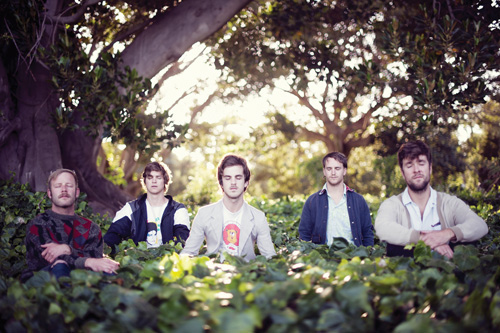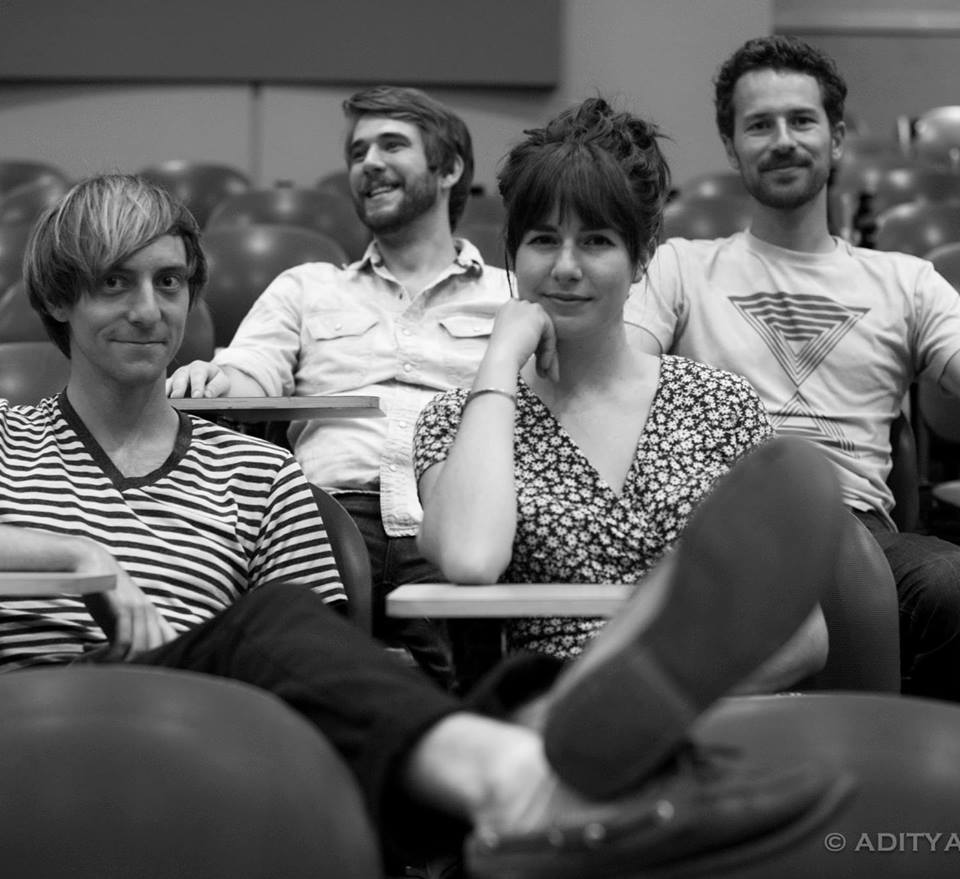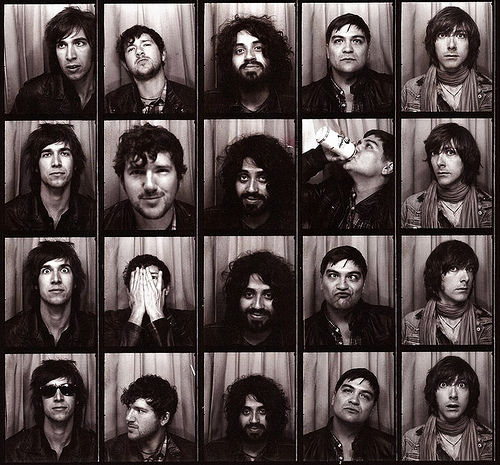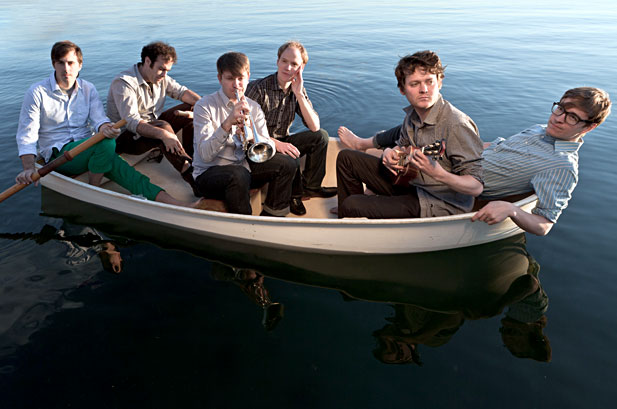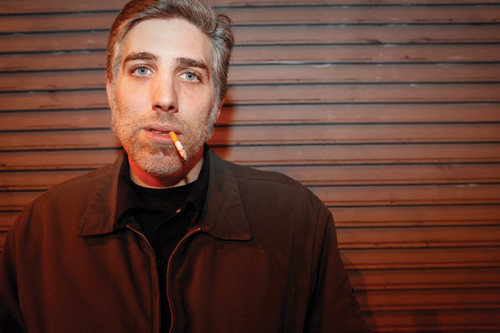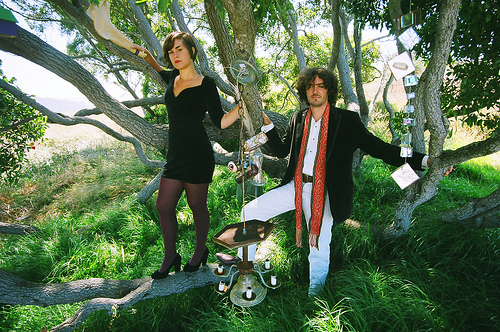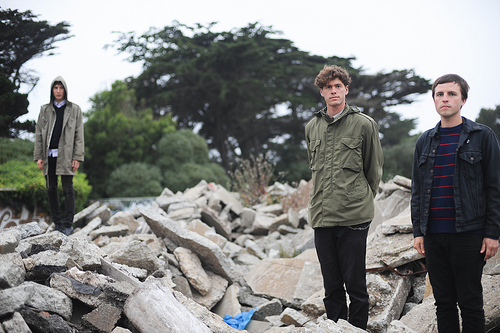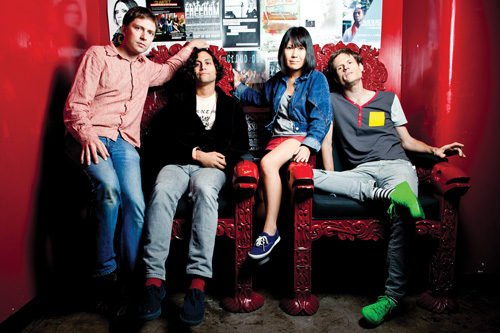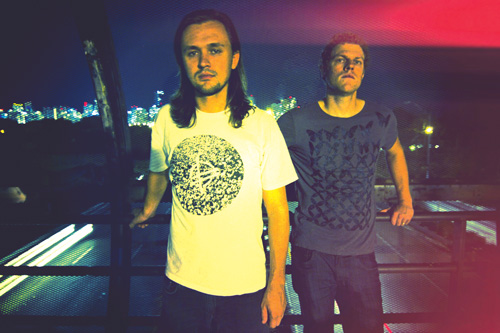WEDNESDAY 28
ROCK/BLUES/HIP-HOP
Active Child, Chad Valley, Silver Swans Bottom of the Hill. 9pm, $12.
Adios Amigo, Nikki Lang Rickshaw Stop. 7pm, $15-$20.
Cabin Project Hotel Utah. 9pm, $10.
Gehenna, Hoax, Neo Cons Sub-Mission, 2183 Mission, SF; www.sf-submission.com. 8pm, $8.
Lance Canales and the Flood Biscuits and Blues. 8 and 10pm, $15.
Lemon Party, Art School Kids, Plastic Villians Knockout. 9pm, $6.
Jonathan Mann, Glowing Stars, Sparky Grinstead and the Mighty Backorder Red Devil Lounge. 8pm, $8.
Mountains, Date Palms, Higuma Hemlock Tavern. 9pm, $8.
Matt Ryd, Xoe Wise Coffee Adventures Cafe, 1331 Columbus, SF; www.myspace.com/coffeeadventures. 11am, free.
Vows/Paranoids, Siddhartha, Black Hole Oscillators Cafe Du Nord. 8pm, $10.
JAZZ/NEW MUSIC
Dink Dink Dink, Gaucho with Tamar Korn, Michael Abraham Amnesia. 7pm, free.
Greg Gotelli Quartet Medjool, 2522 Mission, SF; www.medjoolsf.com. 6-9pm, free.
Jazz organ party with Grahmm Connah Royal Cuckoo, 3202 Mission, SF; www.royalcuckoo.com. 7:30pm, free.
Ricardo Scales Top of the Mark, 999 California, SF; www.topofthemark.com. 6:30pm, $5.
Mitch Winehouse Yoshi’s. 8pm, $20.
FOLK/WORLD/COUNTRY
Dan Mangan Hotel Utah. 9pm, $10.
DANCE CLUBS
Booty Call Q-Bar, 456 Castro, SF; www.bootycallwednesdays.com. 9pm. Juanita Moore hosts this dance party, featuring DJ Robot Hustle.
Club Shutter Elbo Room. 10pm, $5. Goth DJs Nako, Omar, and Justin.
Full-Step! Tunnel Top. 10pm, free. Hip-hop, reggae, soul, and funk with DJs Kung Fu Chris and Bizzi Wonda.
Mary Go Round Lookout, 3600 16th St, SF; www.lookoutsf.com. 10pm, $5. Drag with Suppositori Spelling, Mercedez Munro, and Ginger Snap.
Megatallica Fiddler’s Green, 1333 Columbus, SF; www.megatallica.com. 7pm, free. Heavy metal hangout.
No Room For Squares Som., 2925 16th St, SF; (415) 558-8521. 6-10pm, free. DJ Afrodite Shake spins jazz for happy hour.
THURSDAY 29
ROCK/BLUES/HIP-HOP
All Shall Perish, Fallujah DNA. 7:30pm, free.
Alvon Biscuits and Blues. 8 and 10pm, $15.
Arrica Rose Hotel Utah. 9pm.
Dreamdate, Party Owl, Baby Talk, Big Drag Thee Parkside. 9pm, $5.
Dreams, Tartufi, Debbie Neigher Beatbox, 314 11th St., SF; www.beatboxsf.com. 8pm, $10.
Alex Metric, DJs Aaron and Omar Rickshaw Stop, 10pm, $13.
Revolver, Chateau Marmont, Mist and Mast Bottom of the Hill. 9pm, $12.
Sugar Candy Mountain, Ramon and Jessica, Lone Valkyrie Amnesia. 9pm, $7.
Uzi Rash, Alexis Blair Penney, Hether Fortune Knockout. 9:30pm, $2-$7.
Weedeater, Saviours, Bison, Fight Amp Independent. 8pm, $18.
Young Dubliners Yoshi’s. 8pm, $20.
JAZZ/NEW MUSIC
Blues Organ Party with Chris Siebert Royal Cuckoo, 3202 Mission, SF; www.royalcuckoo.com. 7:30pm, free.
Stompy Jones Top of the Mark, 999 California, SF; www.topofthemark.com. 7:30pm, $10.
Kai Eckhardt Group Savanna Jazz, 2937 MIssion, SF; www.savannajazz.com. 7pm, $10.
Tom Lander and Friends Medjool, 2522 Mission, SF; www.medjoolsf.com. 6-9pm, free.
Robert Glasper Trio Yerba Buena Center for the Arts, 701 Mission, SF; www.ybca.org. 7:30pm, $20-$35.
FOLK/WORLD/COUNTRY
Bluegrass and old-time jam Atlas Cafe, 3049 20th St., SF; www.atlascafe.net. 8-10pm.
Twang! Honky Tonk Fiddler’s Green, 1330 Columbus, SF; www.twanghonkytonk.com. 5pm. Live country music, dancing, and giveaways.
DANCE CLUBS
Afrolicious Elbo Room. 9:30pm, $6. DJs Pleasuremaker and Señor Oz spin Afrobeat, Tropicália, electro, samba, and funk.
Arcade Lookout. 9pm, free. Indie dance party.
Earthdance Afterparty Public Works, 161 Erie, SF; www.publicsf.com.8pm, $10.
Guilty Pleasures Gestalt, 3159 16th St, SF; (415) 560-0137. 9:30pm, free. DJ TophZilla, Rob Metal, DJ Stef, and Disco-D spin punk, metal, electro-funk, and 80s.
1984 Mighty. 9pm, $2. The long-running New Wave and 80s party features video DJs Mark Andrus, Don Lynch, and celebrity guests.
Thursday Special Tralala Revolution Café, 3248 22nd St, SF; (415) 642-0474. 5pm, free. Downtempo, hip-hop, and freestyle beats by Dr. Musco and Unbroken Circle MCs.
Thursdays at the Cat Club Cat Club. 9pm, $6 (free before 9:30pm). Two dance floors bumpin’ with the best of 80s mainstream and underground with Dangerous Dan, Skip, Low Life, and guests.
Tropicana Madrone Art Bar. 9pm, free. Salsa, cumbia, reggaeton, and more with DJs Don Bustamante, Apocolypto, Sr. Saen, Santero, and Mr. E.
Trouble and Bass SF, Drop the Lime, Star Eyes, Deathface Mezzanine. 9pm, $15.
FRIDAY 30
ROCK/BLUES/HIP-HOP
Black Carl Amnesia. 9pm, $7.
Gems, Terry Malts, Tambo Rays Hemlock Tavern. 9:30pm, $6.
Hanni El Khatib, Nick Waterhouse, Dirty Ghosts Bottom of the Hill. 9:30pm, $10.
“Hardly Strictly Bluegrass” Speedway Meadow, Golden Gate Park, SF; www.strictlybluegrass.com. 11am-7pm. With Chris Isaak, Robert Plant and the Band of Joy, Bright Eyes,Felice Brothers, Bill Kirchen, Kurt Vile and more.
High Like Five, Sweet Revenge, Cassandra Farrar Hotel Utah. 830pm, $10.
John Lee Hooker Jr. Biscuits and Blues. 8 and 10pm, $22.
Jayhawks Slim’s. 9pm, $30.
Kindest Lines, Ssleeping Desiress, C.L.A.W.S Rickshaw Stop 9pm, $10.
Mekons Swedish American Music Hall. 8pm, $20.
Nouvelle Vague Regency Ballroom. 9pm, $30.
Odd Future Warfield. 9pm, $30.
Chuck Prophet Make Out Room. 7:30pm, $10.
Quantic Som, 2925 16th St., SF; www.som-bar.com.10pm, $10-$15.
Ralph Carney’s Serious Jass Project Beatbox, 314 11th St., SF; www.beatboxsf.com. 8Pm, $10-$12.
Struts, Rumble Strippers, Jesse Morris Thee Parkside. 9pm, $7.
Tea Leaf Green, Big Light Independent. 9pm, $20.
Victim’s Family, Two Headed Spy, Cold Steel Renegade, Street Eaters Cafe Du Nord. 9pm, $12.
JAZZ/NEW MUSIC
Black Cat Orchestra Top of the Mark, 999 California, SF; www.topofthemark.com. 9pm, $10.
Jazz Organ Party with Grahmm Connah Royal Cuckoo, 3202 Mission, SF; www.royalcuckoo.com. 7:30pm, free.
Earl Klugh Yoshi’s. 8 and10pm, $25-$35.
Petunia and the Vipers, B-Stars, West Coast Ramblers Verdi Club, 2424 Mariposa, SF; www.verdiclub.com. 9:30pm, $15.
Suzanna Smith Savanna Jazz, 2937 MIssion, SF; www.savannajazz.com. 7pm, $8.
DANCE CLUBS
Afro Bao Little Baobab, 3388 19th St, SF; (415) 643-3558. 10pm, $5. Afro and world music with rotating DJs including Stepwise, Steve, Claude, Santero, and Elembe.
Afromassive Elbo Room. 10pm, $10. With Fog Dub.
Blow Up: Designer Drugs DNA. 10pm, $20. With DJ Jeffrey Paradise, Designer Drugs (NYC).
dOP, Deniz Kurtel, Cheatau Flight, Thugfucker Public Works, 161 Erie, SF; www.publicsf.com.10pm, $25.
DJ Premier vs. Pete Rock: The Battle Mighty. 9pm.
DJ Willys Nice Medjool, 2522 Mission, SF; www.medjoolsf.com. 10:30pm, $10.
Pledge: Fraternal Lookout. 9pm, $3-$13. Benefiting LGBT and nonprofit organizations. Bottomless kegger cups and paddling booth with DJ Christopher B and DJ Grind.
Teenage Dance Craze Knockout. 10pm, $4. Surf, garage, and soul with DJs Russell Quan, dX the Funky Granpaw and Okieroan Scott.
Terminator and Reality Check: T-20 Cat Club. 9pm, $5-$7. 20th anniversary party.
Vintage Orson, 508 Fourth St, SF; (415) 777-1508. 5:30-11pm, free. DJ TophOne and guest spin jazzy beats for cocktalians.
Zomby, Machine Drum, Nastynasty103 Harriet, SF; www.1015.com. 9pm, $15.
SATURDAY 1
ROCK/BLUES/HIP-HOP
Basia Bimbo’s. 8pm, $35.
Dark Star Orchestra Regency Ballroom. 9pm, $33.
Fool’s Gold Brick and Mortar. 9pm, $12.
Meat Sluts, Bloody Hells, Yes Gos Bender’s, 806 S. Van Ness, SF; www.bendersbar.com.10pm, $5.
Eggplant Casino 50 Mason Social House, www.50masonsocialhouse.com. 10pm, free.
“Hardly Strictly Bluegrass” Speedway Meadow, Golden Gate Park, SF; www.strictlybluegrass.com. 11am-7pm. With Steve Earle and the Dukes, Allison Moorer, Kris Kristofferson and Merle Haggard, Broken Social Scene, and more.
Hindi Zahra, Karina Denike, Valerie Orth Bottom of the Hill. 9:30pm, $12.
Laurie Morvan Band Biscuits and Blues. 8 and 10pm, $20.
Thee Merry Widows, Undertaker and his Pals, Dirty Hands Family Band Thee Parkside. 9pm, $8.
MK4, Mengz Thee Parkside. 3pm, free.
Chuck Prophet Make Out Room. 7:30pm, $10.
Tea Leaf Green, Big Light Independent. 9pm, $20.
Nathan Temby Johnny Foley’s, 243 O’Farrell, SF; www.duelingpianos.com. 9pm..
Neon Indian, Com Truise, Purity Ring Rickshaw Stop. 9pm, $20.
Toro Y Moi , Unknown Mortal Orchestra, Bass Drum of Death Great American Music Hall. 9pm, $21.
Wrong Words, Royal Headache, Paper Bags Hemlock Tavern. 9:30pm, $7.
Alvin Youngblood Hart Biscuits and Blues. 2pm, $25.
JAZZ/NEW MUSIC
Jazz Organ Party with Jules Broussard and Chris Siebert Royal Cuckoo, 3202 Mission, SF; www.royalcuckoo.com. 7:30pm, free.
Earl Klugh Yoshi’s. 8 and 10pm, $35.
Fernando Otero Florence Gould Theatre, Legion of Honor, SF; www.legionofhonor.famsf.org. 2pm, $20-35.
Jerome Sabbagh, Gary Wang, Tim Bulkley Bliss Bar, 4026 24, SF; www.blissbarsf.com. 2pm, $10.
FOLK/WORLD/COUNTRY
Blind Willies Red Poppy Art House. 8pm, free.
Saturday Night Salsa Ramp, 855 Francois, SF; www.facebook.com/therampsf. 5:30pm, $10.
DANCE CLUBS
Afro Bao Little Baobab, 3388 19th St, SF; (415) 643-3558. 10pm, $5. Afro and world music with rotating DJs including Stepwise, Steve, Claude, Santero, and Elembe.
Debaser Knockout. 9pm, $5. Alternative 90s dance party with DJ Jamie Jams and Emdee of Club Neon.
Drift, SF Harlot, 46 Minna, SF; www.facebook.com/driftsf. 6pm, $10. Dance party for queer women with DJ DRC and DJ Michelle Sanz.
Icee Hot Public Works, 161 Erie, SF; www.publicsf.com. 10m, $10-$15. With Martyn (live), Bok Bok, Girl Unit, Santiago Salazar.
New Wave City Mighty. 9pm, $7-$12.
Prince and MJ Madrone.9pm, $5.
Sanafrica Bollyhood Café. 9pm, $7-10. West African and Latin fusion party with Jose Luis, DJ Nado, and DJ Mignane.
Saturday Night Soul Party Elbo Room. 10pm, $10. DJs Lucky, Paul Paul, and Phengren Oswald spinning ’60s soul 45s.
SUNDAY 2
ROCK/BLUES/HIP-HOP
“Benefit for the San Francisco Food Bank.” Bottom of the Hill. 6:30pm, $10-$20. Working from Home, Deb Thorpe, DJs Leisure Addicts.
Otis Clay, Chick Rodgers Amoeba. 2pm, free.
Lisa Hannigan, John Smith Slim’s. 8pm, $16.
“Hardly Strictly Bluegrass” Speedway Meadow, Golden Gate Park, SF; www.strictlybluegrass.com. 11am-7pm. With Bela Fleck, Devil Makes Three, Bob Mould, Jayhawks, Emmylou Harris, and more.
Jacuzzi Boys, Apache, Midnite Snaxxx Hemlock Tavern. 9pm, $10.
Janeen Leah Brainwash, 1122 Folsom, SF; www.brainwash.com. 6pm.
Redbush, Nerv, Culo a Boca Hemlock Tavern. 4pm, $6.
Caitlin Rose, Emily Greene Cafe Du Nord. 8:30pm, $10
Toro Y Moi , Unknown Mortal Orchestra, Bass Drum of Death Great American Music Hall. 9pm, $21.
Gillian Welch Fillmore. 9pm, $20.
Queensryche Regency Ballroom. 7:30pm, $42.
JAZZ/NEW MUSIC
Blues Organ Party with Lavay Smith and Chris Siebert Royal Cuckoo, 3202 Mission, SF; www.royalcuckoo.com. 7:30pm, free.
Daria, David Bell, Alex Baum Bliss Bar, 4026 24, SF; www.blissbarsf.com. 4:30pm, $10.
Eldar Djangirov Florence Gould Theatre, Legion of Honor, SF; www.legionofhonor.famsf.org. 2Pm, $30-$50.
Rana Farhan Yoshi’s. 7pm, $35.
Four Strange Rivers Percussion Quartet Musician’s Union Hall, 116 Ninth, SF; www.noertker.com. 7:30pm, $10.
French and Kirby Sherman Clay, 647 Mission, SF; www.shermanclay.com. 5pm.
Will and Anthony Nunziata Rrazz Room, 222 Mason, SF; www.rrazzroom.com. 7pm, $35.
Kally Price Old Blues and Jazz Band, Emporer Norton’s Jazz Band Amnesia. 9pm, $5.
Wayne Shorter Quartet Herbst Theater, 401 Van Ness, SF; www.sfwmpac.org. 7pm, $45-$85.
FOLK/WORLD/COUNTRY
Mana Maddy Yoshi’s Lounge. 8pm, $7.
Sunday Night Salsa Ramp, 855 Francois, SF; www.facebook.com/therampsf. 5:30pm, $10.
“Twang Sunday” Thee Parkside. 4pm, free. With Short Fuse, Meatslab, Feral Depravity.
DANCE CLUBS
Batcave Cat Club. 10pm, $5. Death rock, goth, and post-punk with Steeplerot Necromos and c_death.
DJ Moxy 50 Mason Social House, www.50masonsocialhouse.com. 10pm, free.
Dub Mission Elbo Room. 9pm, $6. Dub, roots, and classic dancehall with DJ Sep, Vinnie Esparza and DJ I-Vier.
Jock Lookout, 3600 16th St, SF; www.lookoutsf.com. 3pm, $2. Raise money for LGBT sports teams while enjoying DJs and drink specials.
La Pachanga Blue Macaw, 2565 Mission, SF; www.thebluemacawsf.com. 6pm, $10. Salsa dance party with live Afro-Cuban salsa bands.
MONDAY 3
ROCK/BLUES/HIP-HOP
Built by Stereo, Simon and the Fire Breathers, Meat Market, Younger Lovers Bottom of the Hill. 8:30pm, $8.
River Whyless, Brother Pacific, Beatbeat Whisper Hemlock Tavern. 6pm, $6.
OMD Warfield. 8pm, $35-$45.
Bob Schneider, Piers Faccini Independent. 8Pm, $20.
Stringer Belle, Tori Roze and the Hot Mess, Mermaid Bones Elbo Room.9pm, $6.
World/Inferno Friendship Society Rickshaw Stop. 8pm, $15.
JAZZ/NEW MUSIC
Al Son del Tunduki, Quijerema Yoshi’s. 8pm, $14.
Will and Anthony Nunziata Rrazz Room, 222 Mason, SF; www.rrazzroom.com. 8pm, $35.
DANCE CLUBS
Death Guild DNA Lounge. 9:30pm, $3-5. Gothic, industrial, and synthpop with Joe Radio, Decay, and Melting Girl.
M.O.M. Madrone Art Bar. 6pm, free. DJs Timoteo Gigante, Gordo Cabeza, and Chris Phlek playing all Motown every Monday.
Sausage Party Rosamunde Sausage Grill, 2832 Mission, SF; (415) 970-9015. 6:30-9:30pm, free. DJ Dandy Dixon spins vintage rock, R&B, global beats, funk, and disco at this happy hour sausage-shack gig.
TUESDAY 4
ROCK/BLUES/HIP-HOP
Big D and the Kids Table, Have Nots, Invalids Bottom of the Hill. 9pm, $12.
Big Hurt, Days of High Adventure, Over the Falls Elbo Room, 9pm, 6.
Dum Dum Girls, Crocodiles, Colleen Green Great American Music Hall. 8pm, $17-$19.
Kate Fiano, Paula Boyd Sutor El Rio front room. 7pm, free.
Liam Finn, Marques Toliver Independent. 8pm, $15.
Hoax, Neo Cons, Yadokai Hemlock Tavern. 9pm, $6.
Weapons of the Future, Atomic Mama, Penthouse El Rio back room. 7pm, $5.
JAZZ/NEW MUSIC
Clairdee Rrazz Room, 222 Mason, SF; www.rrazzroom.com. 8pm, $30. Kevin Mahogany Yoshi’s. 8pm, $18.
Music listings are compiled by Emily Savage. Since club life is unpredictable, it’s a good idea to call ahead or check the venue’s website to confirm bookings and hours. Prices are listed when provided to us. Submit items for the listings at listings@sfbg.com. For further information on how to submit items for the listings, see Picks.

